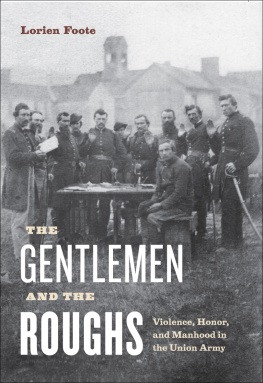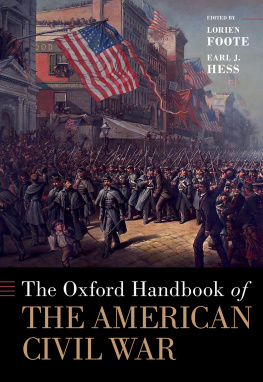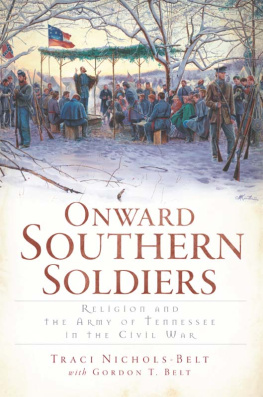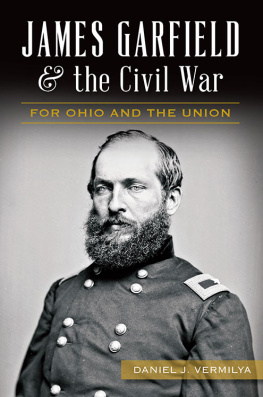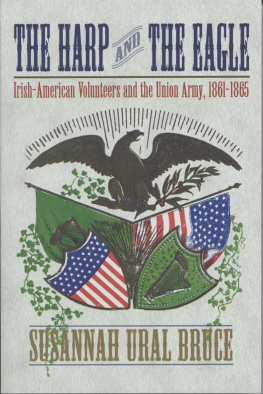Thank you for buying this ebook, published by NYU Press.
Sign up for our e-newsletters to receive information about forthcoming books, special discounts, and more!
Sign Up!
About NYU Press
A publisher of original scholarship since its founding in 1916, New York University Press Produces more than 100 new books each year, with a backlist of 3,000 titles in print. Working across the humanities and social sciences, NYU Press has award-winning lists in sociology, law, cultural and American studies, religion, American history, anthropology, politics, criminology, media and communication, literary studies, and psychology.
The Gentlemen and the Roughs
The Gentlemen and the Roughs
Manhood, Honor, and Violence in the Union Army
Lorien Foote
NEW YORK UNIVERSITY PRESS
New York and London
www.nyupress.org
2010 by New York University
All rights reserved
Portions of were previously published as
Rich Mans War, Rich Mans Fight: Class, Ideology, and
Discipline in the Union Army, Civil War History 51
(September 2005): 269287, and are published here
with permission of Kent State University Press.
Library of Congress Cataloging-in-Publication Data
Foote, Lorien, 1969
The gentlemen and the roughs : violence, honor, and manhood in the Union Army /
Lorien Foote.
p. cm.
Includes bibliographical references and index.
ISBN-13: 9780814727904 (cloth : alk. paper)
ISBN-10: 0814727905 (cloth : alk. paper)
ISBN-13: 9780814727959 (ebook)
ISBN-10: 0814727956 (ebook)
1. United States. ArmyHistoryCivil War, 18611865. 2. United States. ArmyMilitary
lifeHistory19th century. 3. SoldiersUnited StatesSocial conditions19th century.
4. Social classesUnited StatesHistory19th century. 5. Social conflictUnited States
History19th century. 6. ViolenceUnited StatesHistory19th century. 7. Honor
United StatesHistory19th century. 8. MasculinityUnited StatesHistory19th
century. 9. United StatesHistoryCivil War, 18611865Social aspects. I. Title.
E491.F66 2010
973.71dc22 2009053606
New York University Press books are printed on acid-free paper,
and their binding materials are chosen for strength and durability.
We strive to use environmentally responsible suppliers and materials
to the greatest extent possible in publishing our books.
Manufactured in the United States of America
10 9 8 7 6 5 4 3 2 1
For Marlon
Contents
Acknowledgments
Many colleagues, friends, and students have aided me in the research and writing of this book. I am grateful for their hard work, support, and advice, and for the personal and professional courtesy that has been extended to me over the course of this project. First I must thank those who offered unusually generous hospitality to me during my months of research in Washington DC: Greg Eastman, Holly and Kevin Fletcher, and Tom and Bev Lowry. Greg seems to move to the location where I need to research for every new project I undertake, and his free housing has helped support two books and counting. Holly and Kevin allowed me to stay long past the time I probably wore out my welcome and even put off a move to fit my summer research schedule. They are true friends. The Lowrys deserve thanks not only for wonderful mid-afternoon snacking but also for their work creating a searchable electronic record of Union courts-martial. Their years of hard work enabled my project.
I extend special thanks to Dr. Roger Burk of the West Point Systems Engineering Department, who wrote the program that created the database for my project. It was kind of him to take time from his busy teaching and research schedule to help an Excel-challenged historian.
A host of people in a variety of positions at the University of Central Arkansas deserve credit for their assistance with this project. The chair of the History Department, Ken Barnes, supported me in numerous ways for which I am truly grateful. Dean Maurice Lee and the College of Liberal Arts provided me with reassigned time to complete my research. Graduate student Elena Friot entered thousands of pieces of data into an Excel worksheet. Amber Castor was a model summer research assistant who mined the Official Records for orders relating to discipline. Other graduate students who worked on the database for this project or who assisted me in finding sources were Chris Bynum, Rebekah Bilderback, Melissa Moore, John Fisk, Rebecca Stone, and James Conway. My colleagues on the University Research Council granted me the necessary funds to support my research in Washington. Donna Johnson, Judy Huff, and Charlene Bland cheerfully performed any random task that I asked for, and I know I asked for a lot. Student workers Clayton Howell, Sean Flowers, and Kady Williams xeroxed, taped, and pasted on my behalf for hours at a time. Lisa Jernigan is an able and friendly ally in the constant quest for books from interlibrary loan.
The ideas found in this book progressed during the course of several years of thinking, reworking, and rewriting. I owe the evolution of this book and the final product to several generous colleagues who read various stages of the work, provided me with insightful analysis, and offered intriguing ideas for new directions. In particular, a penetrating conversation with Richard Godbeer after he had read a much different version of this work helped to shape the final direction of this project. Michael T. Smith asked me to consider what this book was really about and pointed out the relevance of the Davis-Nelson incident to my work. Andrew Slap returned me to the basics of matching conclusions with evidence and being clear about methodology. Elizabeth Leonard reminded me not to oversimplify. Christian Samito talked me through early ideas for the project. Wendy Lucas-Castro asked me to rethink the final two chapters, and Michael Schaeffers close reading helped to clarify and strengthen the writing. I also would like to thank Amy S. Greenberg and Peter S. Carmichael, who read the manuscript for New York University Press. Their thoughtful and insightful comments offered suggestions that vastly improved the work. This is the place to admit that I did not always listen to advice that I received, and so I take full responsibility for the final content of this book.
It has been a pleasure to work with New York University Press. My editor, Debbie Gershenowitz, recognized the potential of this project in its early stages and has effectively advocated for this book. Her edits made the content better. Perhaps most important, she has made what is often a stressful process seem smooth and pleasant.
I work in a department with a special group of people who are true friends to me. I must thank them for making me laugh when I needed it and for providing support when I was just overwhelmed. You know who you are.
Finally, I would like to thank Jay Dew, because I forgot to last time.
Introduction
The Contested Terms of Manhood
Abraham Lincoln once termed the American Civil War a peoples contest. In contrast to European wars of empire waged by kings and aristocrats, Lincoln believed, it was the northern people who fought the war through democratic institutions to save the worlds only true republic. The most important institution that fought Lincolns peoples contest was the Union Army, a citizen army composed of millions of volunteers and draftees whose numbers dwarfed the small band of regular soldiers and West Point trained officers. The Union Army in the Civil War was northern society in miniature, reflecting its culture and values and imbued with its strengths and weaknesses.

